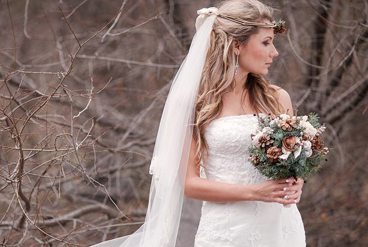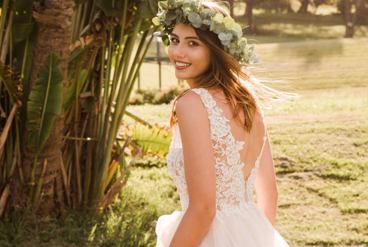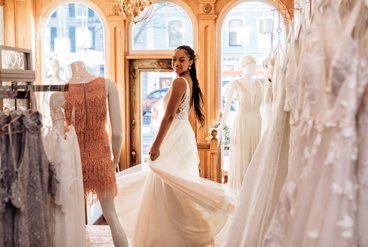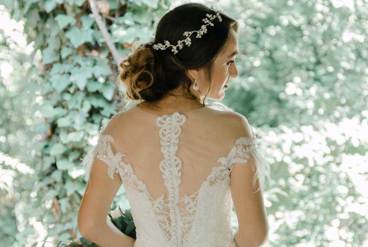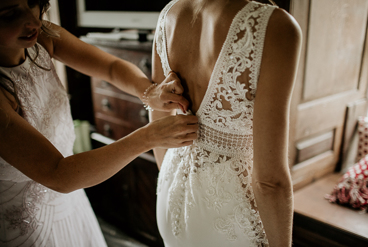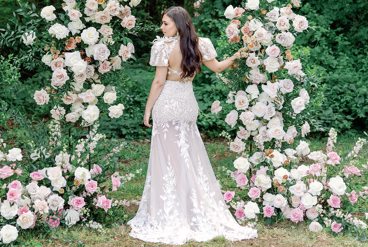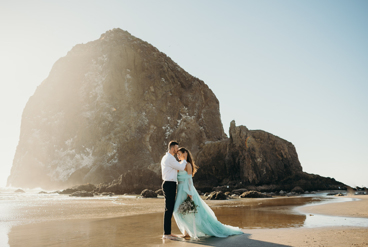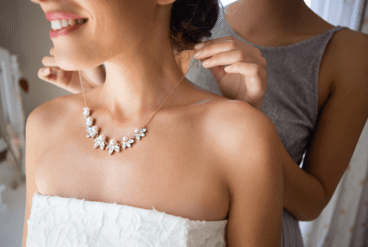تاریخچه جذاب سنت های لباس عروس در سراسر جهان

عروسی یکی از عزیزترین نقاط عطف زندگی است که غرق در عشق، فرهنگ و سنت است. در میان بسیاری از عناصری که یک عروسی را خاص می کند، لباس عروس به عنوان نمادی قدرتمند از تعهد و جشن برجسته است. تاریخچه سنتهای لباس عروس به اندازه فرهنگهایی که از آن سرچشمه میگیرند متنوع است و ارزشهای اجتماعی، آداب و رسوم منطقهای و داستانهای شخصی را منعکس میکند. در این مقاله، سیر تکاملی شگفتانگیز سنتهای لباس عروسی در سراسر جهان را بررسی میکنیم و نشان میدهیم که چگونه این آداب و رسوم در طول زمان تغییر کردهاند و معنای امروزی آنها چیست.
ریشه های لباس عروسی
مفهوم لباس عروس را می توان به تمدن های باستانی ردیابی کرد. در بسیاری از فرهنگها، عروسها بهترین لباسهای خود را برای نشان دادن موقعیت و ثروت خود میپوشیدند. برای مثال، در روم باستان، عروسها تونیکی به نام «استولا» میپوشیدند، که اغلب از پارچههای غنی که با گلدوزیهای پیچیده تزئین شده بود، ساخته میشد. این لباس نماد خلوص بود و معمولاً با حجاب پوشیده میشد، کاری که امروزه در بسیاری از فرهنگها وجود دارد.
تاثیر سلطنت
رنگ و مدل لباس عروس اغلب تحت تاثیر عروسی های سلطنتی بوده است. یکی از مهمترین لحظات در تاریخ لباس عروسی در سال 1840 زمانی رخ داد که ملکه ویکتوریا با شاهزاده آلبرت ساکس کوبورگ و گوتا ازدواج کرد. ملکه ویکتوریا لباس سفیدی را انتخاب کرد که از ساتن ابریشمی ساخته شده بود، که تفاوت آشکاری با لباس های سنتی قرمز یا طلایی زمان خود داشت. این انتخاب رنگ سفید را به عنوان رنگ عروس محبوب کرد و روندی را ایجاد کرد که همچنان بر مد عروسی غربی تسلط دارد.
سنت های لباس عروس در سراسر فرهنگ ها
سنت های غربی
در فرهنگ های غربی، لباس عروس سفید مترادف با پاکی و بی گناهی شد. با این حال، همیشه اینطور نبود. قبل از نفوذ ملکه ویکتوریا، عروس ها لباس هایی در رنگ های مختلف از جمله سایه های قرمز، آبی و حتی مشکی می پوشیدند. امروزه، در حالی که رنگ سفید محبوبترین انتخاب است، بسیاری از عروسها رنگها یا طرحهای متفاوتی را انتخاب میکنند که نشاندهنده سبک شخصی آنهاست.
لوازم عروس: علاوه بر لباس، اکسسوری های عروس نیز نقش تعیین کننده ای در تکمیل ظاهر دارند. معمولاً از روبند، تاج و دسته گل برای بهبود زیبایی کلی استفاده می شود. فروشگاههایی مانند مزون چرخچی طیف گستردهای از اکسسوریهای عروس را ارائه میدهند و این اطمینان را میدهند که هر عروس میتواند قطعاتی را پیدا کند که استایل منحصر به فرد او را تکمیل کند.
سنت های شرقی
برخلاف آداب و رسوم غربی، بسیاری از فرهنگ های شرقی سنت های غنی خود را در مورد لباس عروسی دارند. برای مثال، در هند، عروسها بهطور سنتی از لباسهای سرمهای قرمز یا قهوهای یا لهنگا استفاده میکنند. قرمز نمادی از شکوفایی و باروری است و آن را به انتخابی خوش شانس برای عروس تبدیل می کند. گلدوزیها و تزیینات پیچیده موجود بر روی این لباسها اغلب در طول نسلها منتقل میشوند و لایههایی از اهمیت خانوادگی به لباس اضافه میکنند.
در چین، عروسها معمولاً لباسهای قرمز معروف به «qipao» یا «cheongsam» میپوشند. قرمز رنگ خوش شانسی است که نشان دهنده خوشبختی و خوشبختی است. qipao اغلب با گلدوزی های طلایی که نمادهای رفاه و طول عمر را نشان می دهد تزئین می شود.
سنت های خاورمیانه
عروسی های خاورمیانه نیز دارای لباس های پر جنب و جوش و آراسته هستند. در بسیاری از فرهنگهای عرب، عروسها لباسهای مفصلی میپوشند که ممکن است شامل گلدوزی با نخ طلا یا نقره باشد. لباس سنتی بسته به منطقه متفاوت است. به عنوان مثال، در لبنان، عروسها اغلب لباس سفید میپوشند، اما ممکن است ارسیهای رنگارنگ یا تزئیناتی که میراث آنها را منعکس میکند، به همراه داشته باشند.
سنت های آفریقایی
آفریقا خانه انبوهی از آداب و رسوم عروسی است که فرهنگ های متنوع آن را جشن می گیرند. در بسیاری از کشورهای غرب آفریقا، عروسها لباسهایی با رنگهای روشن میپوشند که از طرحهای مومی یا پارچههای کنته ساخته شدهاند. این لباس ها اغلب با سرپیچ و جواهرات استادانه همراه است. هر منطقه الگوها و سبک های منحصر به فرد خود را دارد که داستان های هویت فرهنگی را بیان می کند.
در آفریقای جنوبی، برخی از عروسها لباسهای سنتی خوسا را انتخاب میکنند که شامل گردنبندها و دامنهای رنگارنگ مهرهای است که با طرحهای پیچیده تزئین شدهاند. این لباس نه تنها زیبایی را نشان می دهد، بلکه به عنوان گواهی بر غرور فرهنگی نیز عمل می کند.
تکامل لباس عروس
همانطور که جوامع تکامل یافته اند، سنت های لباس عروسی نیز تکامل یافته اند. قرن بیستم شاهد تغییرات قابل توجهی در مد لباس عروس بود. پس از جنگ جهانی دوم، لباس های عروسی شروع به بازتاب سبک های معاصر تحت تأثیر فرهنگ عامه کردند. طراحانی مانند کریستین دیور سیلوئت های جدیدی را معرفی کردند که بر زنانگی و ظرافت تأکید داشت.
اواخر قرن بیستم تغییر به سمت انتخاب های شخصی تر در مد لباس عروس را نشان داد. عروسها شروع به جستجوی سبکهای منحصربهفردی کردند که به جای انطباق با هنجارهای سنتی، شخصیت آنها را منعکس کند. این روند راه را برای طرحها و اجارههای سفارشی هموار کرد - گزینههایی که عروسهای مدرن امروزی میتوانند آنها را بررسی کنند.
روندهای مدرن و سفارشی سازی
عروس های امروزی برای انتخاب لباس عروسی خود، انتخاب های مختلفی دارند. از مانتوهای سنتی گرفته تا کت و شلوارهای مدرن، گزینه ها نامحدود هستند. بسیاری از عروس ها برای ایجاد لباسی که چشم انداز آنها را تجسم می بخشد، سفارشی سازی را انتخاب می کنند. فروشگاه هایی مانند مزون چرخچی خدماتی را برای طراحی و دوخت لباس عروس ارائه می دهند و به عروس ها اجازه می دهند تا با طراحان برای خلق چیزی واقعا منحصر به فرد همکاری کنند.
علاوه بر این، خدمات اجاره محبوبیت پیدا کرده است، زیرا عروس ها به دنبال گزینه های پایدار بدون به خطر انداختن سبک هستند. اجاره لباس عروس به عروس خانم ها این امکان را می دهد تا برای روز خاص خود از لباس های با کیفیت بالا و بدون هزینه های سنگین استفاده کنند.
اهمیت فرهنگی لباس عروس
فراتر از زیبایی شناسی، لباس عروس دارای اهمیت فرهنگی عمیقی است. آنها اغلب نماد میراث خانواده و ارزش های جامعه هستند. به عنوان مثال، در برخی از فرهنگها، معمولاً عروسها از لباسهای میراث خانوادگی یا لباسهایی استفاده میکنند که نسلها به نسلها منتقل شده است.
در بسیاری از جوامع، لباس پوشیدن برای عروسی صرفاً برای زیبا به نظر رسیدن نیست. همچنین در مورد احترام به سنت ها و آیین هایی است که برای قرن ها رعایت شده است. انتخاب پارچه، رنگ و طرح می تواند پیام هایی را در مورد موقعیت اجتماعی، هویت فرهنگی و باورهای شخصی منتقل کند.
نقش اکسسوری های عروس
اکسسوری های عروس بخش مهمی از لباس عروسی هستند و به طور قابل توجهی به ظاهر کلی شما کمک می کنند. از روبند گرفته تا کفش، هر قطعه نقشی در تکمیل مجموعه عروس دارد. لوازم جانبی همچنین می توانند ارزش احساسی داشته باشند. بسیاری از عروسها انتخاب میکنند که چیزی قرضی یا قدیمی را به عنوان بخشی از سنت «چیزی آبی» بپوشند.
مزون چرخچی نه تنها لباس عروس های خیره کننده ای ارائه می دهد، بلکه مجموعه ای از اکسسوری های عروس را نیز ارائه می دهد که می تواند هر ظاهری را زیباتر کند. این اکسسوری ها چه یک حجاب ظریف یا زیورآلات معمولی باشند، به عروس ها کمک می کنند تا شخصیت خود را در عین رعایت هنجارهای سنتی نشان دهند.
نتیجه گیری
تاریخچه سنت های لباس عروس در سراسر جهان سفری فریبنده در زمان و فرهنگ است. از لباسهای باستانی گرفته تا طرحهای معاصر، هر سنت داستانی درباره عشق، تعهد و هویت فرهنگی دارد. در حالی که روندهای مدرن سبک ها و گزینه های جدیدی را معرفی کرده اند - مانند اجاره و طرح های سفارشی - بسیاری از عروس ها هنوز از احترام به عناصر سنتی که آنها را به میراثشان متصل می کند، لذت می برند.
همانطور که سفر عروسی خود را آغاز می کنید، به یاد داشته باشید که لباس شما چیزی فراتر از پارچه است. این بازتابی از شخصیت شما به عنوان یک فرد و به عنوان بخشی از یک روایت بزرگتر است. چه انتخاب کنید که لباس مجلسی را از مزون چرخچی کرایه کنید یا لباس منحصر به فرد خود را طراحی کنید، اجازه دهید لباس عروسی شما جشنی از عشق باشد که فراتر از زمان و سنت است.
در اصل، لباس عروس فقط یک لباس نیست. این نمادی از امید، شادی، و شروع های جدید است - یادآوری بی انتها که عشق هیچ حد و مرزی نمی شناسد.
The Fascinating History of Wedding Dress Traditions Around the World
Weddings are one of life’s most cherished milestones, steeped in love, culture, and tradition. The wedding dress stands out as a powerful symbol of commitment and celebration among the many elements that make a wedding special. The history of wedding dress traditions is as diverse as the cultures they originate from, reflecting societal values, regional customs, and personal stories. In this article, we will explore the fascinating evolution of wedding dress traditions worldwide, highlighting how these customs have changed over time and what they mean today.
The Origins of Wedding Attire
The concept of a wedding dress can be traced back to ancient civilizations. In many cultures, brides wore their finest garments to signify their status and wealth. For instance, in ancient Rome, brides donned a "stola" tunic, often made from rich fabrics adorned with intricate embroidery. This garment symbolized purity and was typically worn with a veil, a practice that persists in many cultures today.
The Influence of Royalty
The color and style of wedding dresses have often been influenced by royal weddings. One of the most significant moments in wedding dress history occurred in 1840 when Queen Victoria married Prince Albert of Saxe-Coburg and Gotha. Queen Victoria chose to wear a white gown made of silk satin, a stark departure from the traditional red or gold dresses of her time. This choice popularized white as the color for brides and set a trend that continues to dominate Western wedding fashion.
Wedding Dress Traditions Across Cultures
Western Traditions
In Western cultures, the white wedding dress became synonymous with purity and innocence. However, this wasn't always the case. Before Queen Victoria's influence, brides wore dresses in various colors, including shades of red, blue, and even black. Today, while white remains the most popular choice, many brides opt for different colors or designs that reflect their style.
Bridal Accessories: In addition to the dress, bridal accessories play a crucial role in completing the look. Veils, tiaras, and bouquets are commonly used to enhance the overall aesthetic. Stores like Mezon Charkhchi offer a wide range of bridal accessories, ensuring that every bride can find pieces that complement her unique style.
Eastern Traditions
In contrast to Western customs, many Eastern cultures have their rich traditions surrounding wedding attire. In India, for example, brides traditionally wear a red or maroon saree or lehenga. Red symbolizes prosperity and fertility, making it an auspicious choice for brides. The intricate embroidery and embellishments found on these garments are often passed down through generations, adding layers of familial significance to the attire.
In China, brides typically wear red dresses known as "qipao" or "cheongsam." Red is considered a lucky color that represents happiness and good fortune. The qipao is often adorned with gold embroidery depicting symbols of prosperity and longevity.
Middle Eastern Traditions
Middle Eastern weddings also feature vibrant and ornate attire. In many Arab cultures, brides wear elaborate gowns that may include gold or silver thread embroidery. The traditional attire varies by region; for instance, in Lebanon, brides often wear white but may incorporate colorful sashes or embellishments that reflect their heritage.
African Traditions
Africa is home to a plethora of wedding customs that celebrate its diverse cultures. In many West African countries, brides wear brightly colored dresses made from wax prints or kente cloth. These garments are often accompanied by head wraps and elaborate jewelry. Each region has its unique patterns and styles that tell stories of cultural identity.
In South Africa, some brides choose to wear traditional Xhosa attire, which includes colorful beaded necklaces and skirts adorned with intricate designs. The attire not only reflects beauty but also serves as a testament to cultural pride.
The Evolution of Wedding Dresses
As societies have evolved, so too have wedding dress traditions. The 20th century saw significant changes in bridal fashion. After World War II, wedding dresses began to reflect contemporary styles influenced by popular culture. Designers like Christian Dior introduced new silhouettes that emphasized femininity and elegance.
The late 20th century marked a shift towards more personalized choices in bridal fashion. Brides began to seek unique styles that reflected their individuality rather than conforming to traditional norms. This trend paved the way for custom designs and rentals—options that modern brides can explore today.
### Modern Trends and Customization
Today’s brides have an array of choices when it comes to selecting their wedding dress. From traditional gowns to modern jumpsuits, the options are limitless. Many brides opt for customization to create a gown that embodies their vision. Stores like Mezon Charkhchi offer services for wedding dress design and sewing, allowing brides to collaborate with designers to create something truly unique.
Moreover, rental services have gained popularity as brides seek sustainable options without compromising on style. Renting a wedding dress allows brides to wear high-quality designer pieces for their special day without the hefty price tag.
Cultural Significance of Wedding Dresses
Beyond aesthetics, wedding dresses carry deep cultural significance. They often symbolize family heritage and community values. For instance, in some cultures, it is customary for brides to wear family heirlooms or garments that have been passed down through generations.
In many societies, the act of dressing up for a wedding is not merely about looking beautiful; it is also about honoring traditions and rituals that have been observed for centuries. The choice of fabric, color, and design can convey messages about social status, cultural identity, and personal beliefs.
The Role of Bridal Accessories
Bridal accessories are an essential part of the wedding outfit and contribute significantly to the overall look. From veils to shoes, each piece plays a role in completing the bride’s ensemble. Accessories can also hold sentimental value; many brides choose to wear something borrowed or something old as part of their "something blue" tradition.
Mezon Charkhchi not only offers stunning wedding dresses but also provides an array of bridal accessories that can elevate any look. Whether it's a delicate veil or statement jewelry, these accessories help brides express their individuality while adhering to traditional norms.
Conclusion
The history of wedding dress traditions around the world is a captivating journey through time and culture. From ancient garments to contemporary designs, each tradition tells a story about love, commitment, and cultural identity. While modern trends have introduced new styles and options—such as rentals and custom designs—many brides still find joy in honoring traditional elements that connect them to their heritage.
As you embark on your wedding journey, remember that your dress is more than just fabric; it’s a reflection of who you are as an individual and as part of a larger narrative. Whether you choose to rent a gown from Mezon Charkhchi or design your unique piece, let your wedding dress be a celebration of love that transcends time and tradition.
In essence, the wedding dress is not just an outfit; it’s a symbol of hope, happiness, and new beginnings—a timeless reminder that love knows no boundaries or borders.




